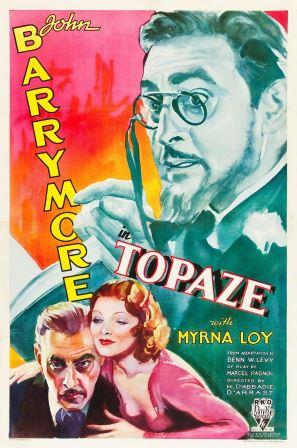In the role he chose above all others…in the play that made Broadway throngs laugh and cry for a year!
In 1933 actor John Barrymore was at the top of his profession, being among the (if not the) premier actor of his day. In 1933 alone, Barrymore would star in five feature films, among them that year’s critically acclaimed Topaze. Though an interesting film billed strangely as a comedy that was a success on its original release, it’s languished in near obscurity since.
Based on a French play of the same name, Topaze is the story of a moralistic professor (Barrymore as Professor Topaze) who looses his teaching position after refusing to pass the influential Baron’s (Reginald Mason as Baron Philippe La Tour-La Tour) immature son. Looking for his next job, he goes to an interview with Coco (Myna Loy), whose looking for help for her nephew. During the interview he meets and joins forces with Baron La Tour in promoting a curative miracle water, to be named Topaze.
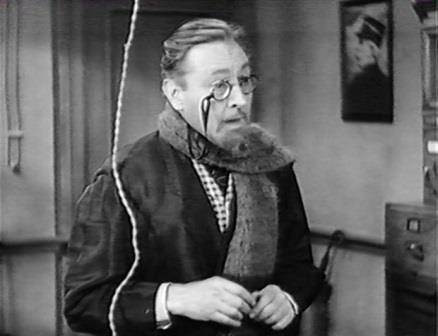 Over time Topaze learns that the product bearing his name is pure hokum, but on learning that everyone’s in on the take he decides to go with the old maxim, “If you can’t beat them, join them.” Topaze becomes vindictive and leverages his position into part owner of the Baron’s enterprises and working the system diabolically to his own advantage. Finally, at the movie’s close, Topaze makes the graduation speech to his old student at the academy, making both pointed jabs at the system and those who’ve corrupted it while embracing the corruption himself.
Over time Topaze learns that the product bearing his name is pure hokum, but on learning that everyone’s in on the take he decides to go with the old maxim, “If you can’t beat them, join them.” Topaze becomes vindictive and leverages his position into part owner of the Baron’s enterprises and working the system diabolically to his own advantage. Finally, at the movie’s close, Topaze makes the graduation speech to his old student at the academy, making both pointed jabs at the system and those who’ve corrupted it while embracing the corruption himself.
Topaze is all about John Barrymore as one would expect. He’s in most every scene and he’s almost overly central to the film’s somewhat thin plot. He’s of course outstanding, though there are some signs of puffiness and the ravages of his alcoholism in his appearance. It’s an oddly satisfying performance in a new way for fans of Barrymore. Here he isn’t at the point of being a near caricature of the character he’s portraying. Rather, he’s more mundane, being equally effective as the meek and almost dimwitted professor who slowly learns how to manipulate the system only as his naivete falls away.
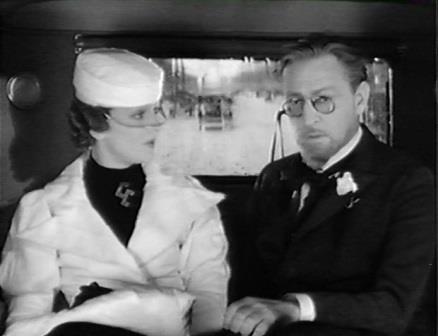 The rest of the cast has little to do, as even Myrna Loy as Coco, the Baron’s mistress, seems woefully underutilized. Her best scene is the opening one of the film, where she is sitting in presumed domestic bliss with the Baron. Only later do we learn that she’s his mistress and not his wife, but in spite of this she comes off without any prejudices moving ahead, though the casual treatment of adultery here did prevent a rerelease in 1936. As she becomes Topaze’s lab assistant and friend she still doesn’t develop much. It’s only at the end, when she’s apparently dropped the Baron in favor of Topaze himself, that you realize that she’s just working the system too. Just take a look at the film’s name on the marque (Man, Woman and Sin) that the two walk into in the finale.
The rest of the cast has little to do, as even Myrna Loy as Coco, the Baron’s mistress, seems woefully underutilized. Her best scene is the opening one of the film, where she is sitting in presumed domestic bliss with the Baron. Only later do we learn that she’s his mistress and not his wife, but in spite of this she comes off without any prejudices moving ahead, though the casual treatment of adultery here did prevent a rerelease in 1936. As she becomes Topaze’s lab assistant and friend she still doesn’t develop much. It’s only at the end, when she’s apparently dropped the Baron in favor of Topaze himself, that you realize that she’s just working the system too. Just take a look at the film’s name on the marque (Man, Woman and Sin) that the two walk into in the finale.
Topaze himself is a bit of a dichotomy, for while it’s clear at the onset that he’s a man of high morals and strong ethical standards. As things progress it’s equally clear that he gives up fighting the system and instead embraces it to get his piece of the action as well. At the end, we sense there might still be some conflict internally as he almost revisits his academic start, using the forum to skewer his rivals and their schemes. Yet in his final judgement, it’s pretty clear that his diatribe against the schemers was likely just to further enhance his new empire. It’s clear he’s now firmly in camp with the rest, feeling that with the right connections and right leverage he can get just about anything, even the Baron’s girl.
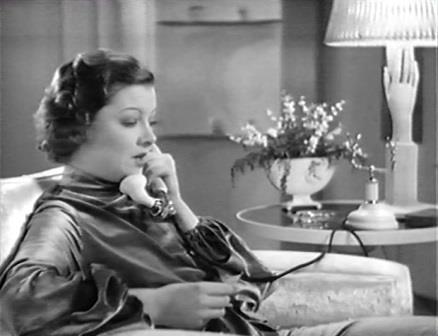 The biggest challenge I have with Topaze is its moral ambiguity. Everyone’s out to play the system to their own benefit, from the Baron to Topaze to government committees to Coco. It’s a very heavy message, though strangely marketed as a comedy (it’s still listed as such). Though the Ben Hecht screenplay has some witty and well written dialogue, much of what’s intended as humor that it borders on the sardonic, being almost painfully cutting and highlighting even more this environment full of graft and corruption. Sadly, finding out that Topaze (the product) is completely fraudulent is only the tip of the iceberg. It’s an enjoyable film but at times challenging to watch as a result.
The biggest challenge I have with Topaze is its moral ambiguity. Everyone’s out to play the system to their own benefit, from the Baron to Topaze to government committees to Coco. It’s a very heavy message, though strangely marketed as a comedy (it’s still listed as such). Though the Ben Hecht screenplay has some witty and well written dialogue, much of what’s intended as humor that it borders on the sardonic, being almost painfully cutting and highlighting even more this environment full of graft and corruption. Sadly, finding out that Topaze (the product) is completely fraudulent is only the tip of the iceberg. It’s an enjoyable film but at times challenging to watch as a result.
What you do see is some of the mastery of producer David O. Selznick at work, though still a few years from his own masterpiece. Besides the rather offbeat casting of Barrymore himself, you can see that there’s significant time spent on making the film feel less stagey. There’s a great extended scene early with a constant snowfall to be seen outside the professor’s classroom windows and also sharp rear projection work during a car ride that are pretty well done for the day. Of course many from the picture, including Barrymore, Loy and Selznick himself would depart for MGM shortly after Topaze.
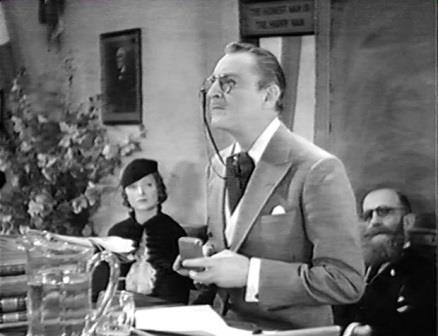 Regardless of your take on the film, (many do realize the comedic aspects and either overlook or ignore the rather dark message) it’s far too good a film to be relegated to the dustbin of film history. It’s definitely worth watching for a somewhat unique (not over the top) performance by John Barrymore and one of the last looks at Myrna Loy before her career took off.
Regardless of your take on the film, (many do realize the comedic aspects and either overlook or ignore the rather dark message) it’s far too good a film to be relegated to the dustbin of film history. It’s definitely worth watching for a somewhat unique (not over the top) performance by John Barrymore and one of the last looks at Myrna Loy before her career took off.
